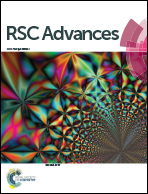Construction and properties of the antibacterial epitaxial transition layer on a zirconia ceramic surface
Abstract
Secondary caries is one of the main causes of dental zirconia restoration failure in the clinic. Therefore, it is urgent to improve the antibacterial performance of zirconia ceramics to reduce the occurrence of secondary caries. In this study, a quaternary ammonium compound antibacterial polymer was innovatively synthesized by solution polymerization with a quaternary ammonium salt monomer as the antibacterial component. The antibacterial epitaxial transition layer was successfully prepared on the surface of zirconia ceramics by the hydroxyl group on HEMA reacting with the siloxane group in the KH570 hydrolysate, which makes the antibacterial polymer indirectly chemically combine with the silicate epitaxial transition layer. The antibacterial epitaxial transition layer exhibited excellent mechanical properties, satisfactory biocompatibility and significant antibacterial effects, and the maximum antibacterial rate is 99%. The antibacterial epitaxial transition layer plays an important role in preventing secondary caries and improving the success rate of clinical zirconia ceramic restorations.



 Please wait while we load your content...
Please wait while we load your content...